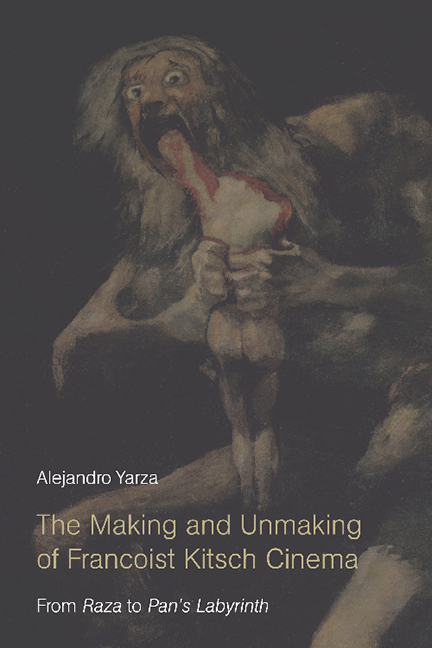Book contents
- Frontmatter
- Contents
- List of Figures
- Acknowledgments
- Preface
- Introduction
- 1 The Petrified Tears of General Franco: Kitsch and Fascism in José Luis Sáenz de Heredia’s Raza
- 2 Romancero Marroquí and the Francoist Kitsch Politics of Time
- 3 Los últimos de Filipinas: The Spatio-temporal Coordinates of Francoism
- 4 Surcos: Neorealism, Film Noir, and the Puppet Master
- 5 Franco, Ese Hombre: From Kitsch-Artist to Kitsch-Man
- 6 Viridiana: The World, the Flesh, and the Devil
- 7 Balada Triste De Trompeta: Of Ghosts and Clowns
- 8 Under the Sign of Saturn: The Labyrinth of Moral Choices in Francoist Spain
- Works Cited
- Index
5 - Franco, Ese Hombre: From Kitsch-Artist to Kitsch-Man
Published online by Cambridge University Press: 10 November 2020
- Frontmatter
- Contents
- List of Figures
- Acknowledgments
- Preface
- Introduction
- 1 The Petrified Tears of General Franco: Kitsch and Fascism in José Luis Sáenz de Heredia’s Raza
- 2 Romancero Marroquí and the Francoist Kitsch Politics of Time
- 3 Los últimos de Filipinas: The Spatio-temporal Coordinates of Francoism
- 4 Surcos: Neorealism, Film Noir, and the Puppet Master
- 5 Franco, Ese Hombre: From Kitsch-Artist to Kitsch-Man
- 6 Viridiana: The World, the Flesh, and the Devil
- 7 Balada Triste De Trompeta: Of Ghosts and Clowns
- 8 Under the Sign of Saturn: The Labyrinth of Moral Choices in Francoist Spain
- Works Cited
- Index
Summary
Franco is a sphinx but he has no secret
—Pedro Sáinz Rodríguez, Franco's first Minister of EducationTo commemorate twenty-five years of Franco's regime, Raza's director, José Luis Sáenz de Heredia, made a documentary in 1964 about Franco titled Franco, ese hombre. As we saw in Chapter 1, Franco's screenplay for Raza was a narcissistic fantasy in which the dictator created an alter-ego for the silver screen—the character of José Churruca—in order to project himself as the ideal hero Spain needed to save the country. Made twenty-two years later, Franco, ese hombre attempts to render the elderly, historical Franco as such a hero and, in doing so, rewrites Spanish history according to Francoist ideological and political clichés.
As its title suggests, Sáenz de Heredia made the film to bring Franco closer to the average Spaniard by revealing his human side. In this chapter, I will argue that Franco, ese hombre betrays Sáenz de Heredia's proclaimed intention. Instead of bringing Franco closer to us, it creates a myth out of the man. The mythologizing of Franco as Spain's savior relies upon the ideological fabrication of historical truth, which transforms the documentary into a kitsch fiction masquerading as a document of truth. To accomplish this, it resorts to the formal traits of standard documentary, what Carl R. Plantinga has called the “formal voice documentary,” featuring voice-over, archival footage, still photographs, interviews with expert witnesses, etc. (110).
A critical strategy used to create a fictional portrait of Franco as a mythical character, father figure, and moral compass of the nation is the interaction between what Michel Chion termed the acousmêtre—the ‘acousmatic,’ invisible presence of the voice-over (21)—and the silent images of Franco culled from archival footage. I will return to this toward the end of the chapter. However, the documentary's successful creation of the myth of Franco as a major global historical figure—compared by the voice-over to Napoleon as the youngest general in Europe—is shattered in the final scene by the appearance of Franco himself—the real man. In this last scene of the film, in which Franco is interviewed by Sáenz de Heredia, Franco looks awkwardly off-camera as he answers the director's questions while reading banal answers from cue cards written for him by José Sánchez Silva, the documentary's co-screenwriter.
- Type
- Chapter
- Information
- The Making and Unmaking of Francoist Kitsch CinemaFrom Raza to Pan's Labyrinth, pp. 141 - 178Publisher: Edinburgh University PressPrint publication year: 2017



